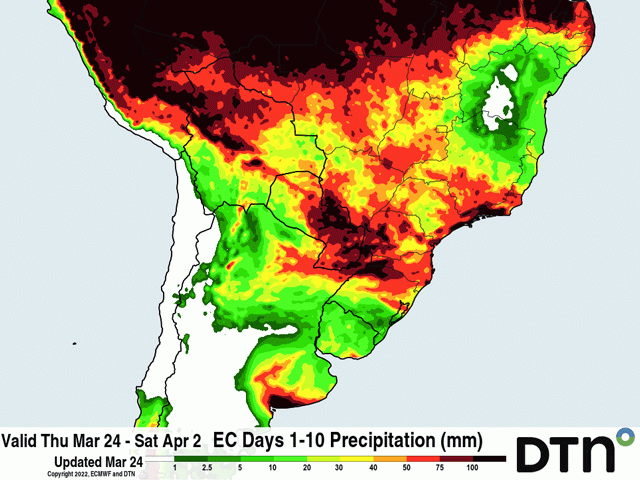Showers in Brazil Crop Weather Forecast
Mixed Weather Conditions for Second-Crop Corn in Brazil
The crop season continues in Argentina as much of the late-planted corn and soybeans are in reproductive or filling stages of growth. But the attention is starting to turn northward in Brazil. The second-crop (safrinha) corn in the country is essentially all in the ground and developing quickly.
The central states of Mato Grosso, Goias, and Minas Gerais account for about 60% of safrinha corn production have been completely planted for a couple of weeks now, being planted in mostly wet soils. Rainfall was good for the first-crop soybeans and built in some good subsoil moisture for early development of safrinha corn. However, showers in March have been much more isolated and weaker than we typically see for the month. Deficits estimated at greater than 100 millimeters (more than 4 inches) can be found in Goias and Minas Gerais with lower deficits in Mato Grosso around 50 to 100 mm (about 2 to 4 inches). Deficits this large start to eat into the subsoil moisture as corn grows and demands more water.
P[L1] D[0x0] M[300x250] OOP[F] ADUNIT[] T[]
This is coming at a time when producers are banking on increasing soil moisture for the upcoming dry season. Typically, the dry season starts the first few days of May. However, during La Nina conditions which we currently find ourselves, the wet season usually ends a week or two early. If that holds true, the wet season will only last another three to four weeks before rains dry up and corn is forced to endure development on subsoil moisture alone. Large portions of the crop would therefore be in their pollination and early fill periods when the rain ends. A continued outlook of below-normal precipitation would likely be damaging, even though much of the crop has been planted in the preferred window.
Farther to the south, there is still a little planting left to go on the safrinha crop. The Department of Rural Economics (DERAL) in the state of Parana estimates that 94% of the corn crop has been planted as of March 21, with 83% of the crop in the early development stages. Nine percent of the crop is flowering, however, so precipitation will be key during the next few weeks to ensure good pollination of kernels.
Moisture in this part of the country was hard to come by for the first-crop soybeans and production has fallen significantly from estimates both public and private. That set up the safrinha corn in drought conditions that needed significant rains to flip prospects from poor to good. Largely, that has occurred in March. Rainfall surpluses of up to 100 mm (about 4 inches) are estimated from Parana down through Rio Grande do Sul in far southern Brazil, as well as above-normal precipitation amounts in Paraguay. The increased soil moisture has improved the conditions for planting, germination, and early growth. DERAL estimates that 95% of the safrinha corn crop is currently rated as good or excellent. That is a far cry from first-crop soybeans, which were hovering in the 30% to 40% range for through flowering and grain-fill stages.
Now that we have that under our belts, we look to the forecast to see how conditions may change. During the next week, southern Brazil looks to have favorable precipitation coming in two rounds. The first is underway and will produce some relatively good precipitation, up to 50 mm (about 2 inches) through March 25. The following week, a front will quickly move through the region but still produce scattered showers and thunderstorms with potential for another 50 mm (about 2 inches). As these fronts move into central Brazil, however, showers get much more isolated and spread out. Some areas will do just fine getting the precipitation they need, especially in Mato Grosso. But other areas will not fare as well. The overall drought continuing in the south, plus the expanding dryness in the middle of the country, will still cause concern about safrinha corn production for producers. The longer-range implications on drier conditions over central Brazil may lead to production estimate decreases, but that will depend on the actual end of the wet season and whether or not showers increase before it does. Fronts moving through Argentina and southern Brazil stall out in central Brazil going through at least the first half of April, keeping showers in place even if they are less intense. That could be enough timely rain to relieve corn from drawing too much out of the subsoils before the rains shut down.
To find more international weather conditions and your local forecast from DTN, head over to https://www.dtnpf.com/…
John Baranick can be reached at john.baranick@dtn.com
(c) Copyright 2022 DTN, LLC. All rights reserved.




